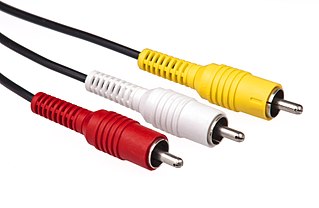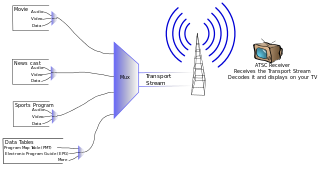In signal processing, a passthrough is a logic gate that enables a signal to "pass through" unaltered, sometimes with little alteration. Sometimes the concept of a "passthrough" can also involve daisy chain logic.
In signal processing, a passthrough is a logic gate that enables a signal to "pass through" unaltered, sometimes with little alteration. Sometimes the concept of a "passthrough" can also involve daisy chain logic.
In telecommunications, squelch is a circuit function that acts to suppress the audio output of a receiver in the absence of a strong input signal. Essentially, squelch is a specialized type of noise gate designed to suppress weak signals. Squelch is used in two-way radios and VHF/UHF radio scanners to eliminate the sound of noise when the radio is not receiving a desired transmission.
A signal generator is one of a class of electronic devices that generates electrical signals with set properties of amplitude, frequency, and wave shape. These generated signals are used as a stimulus for electronic measurements, typically used in designing, testing, troubleshooting, and repairing electronic or electroacoustic devices, though it often has artistic uses as well.
Demodulation is extracting the original information-bearing signal from a carrier wave. A demodulator is an electronic circuit that is used to recover the information content from the modulated carrier wave. There are many types of modulation so there are many types of demodulators. The signal output from a demodulator may represent sound, images or binary data.

An RF modulator is an electronic device used to convert signals from devices such as media players, VCRs and game consoles to a format that can be handled by a device designed to receive a modulated RF input, such as a radio or television receiver. Its input is a baseband signal, which is used to modulate a radio frequency source.

SCART is a French-originated standard and associated 21-pin connector for connecting audio-visual (AV) equipment. The name SCART comes from Syndicat des Constructeurs d'Appareils Radiorécepteurs et Téléviseurs, "Radio and Television Receiver Manufacturers' Association", the French organisation that created the connector in the mid-1970s. The related European standard EN 50049 has then been refined and published in 1978 by CENELEC, calling it péritelevision, but it is commonly called by the abbreviation péritel in French.
Receiver or receive may refer to:

The RCA connector is a type of electrical connector commonly used to carry audio and video signals. The name RCA derives from the company Radio Corporation of America, which introduced the design in the 1930s. The connectors male plug and female jack are called RCA plug and RCA jack.
Dolby Pro Logic is a surround sound processing technology developed by Dolby Laboratories, designed to decode soundtracks encoded with Dolby Surround. The terms Dolby Stereo and LtRt are also used to describe soundtracks that are encoded using this technique.

In radio communications, a radio receiver, also known as a receiver, a wireless, or simply a radio, is an electronic device that receives radio waves and converts the information carried by them to a usable form. It is used with an antenna. The antenna intercepts radio waves and converts them to tiny alternating currents which are applied to the receiver, and the receiver extracts the desired information. The receiver uses electronic filters to separate the desired radio frequency signal from all the other signals picked up by the antenna, an electronic amplifier to increase the power of the signal for further processing, and finally recovers the desired information through demodulation.

A tuner is a subsystem that receives radio frequency (RF) transmissions, such as FM broadcasting, and converts the selected carrier frequency and its associated bandwidth into a fixed frequency that is suitable for further processing, usually because a lower frequency is used on the output. Broadcast FM/AM transmissions usually feed this intermediate frequency (IF) directly into a demodulator that converts the radio signal into audio-frequency signals that can be fed into an amplifier to drive a loudspeaker.

A video display controller or VDC is an integrated circuit which is the main component in a video-signal generator, a device responsible for the production of a TV video signal in a computing or game system. Some VDCs also generate an audio signal, but that is not their main function.

An ATSCtuner, often called an ATSC receiver or HDTV tuner, is a type of television tuner that allows reception of digital television (DTV) television channels that use ATSC standards, as transmitted by television stations in North America, parts of Central America, and South Korea. Such tuners are usually integrated into a television set, VCR, digital video recorder (DVR), or set-top box which provides audio/video output connectors of various types.

An audio/video receiver (AVR) is a consumer electronics component used in a home theater. Its purpose is to receive audio and video signals from a number of sources, and to process them and provide power amplifiers to drive loudspeakers and route the video to displays such as a television, monitor or video projector. Inputs may come from a satellite receiver, radio, DVD players, Blu-ray Disc players, VCRs or video game consoles, among others. The AVR source selection and settings such as volume, are typically set by a remote controller.

The Dreamcast VGA Box is an accessory for Sega's Dreamcast video game console that allows it to connect to a video display such as a computer monitor or an HDTV set through a VGA port. Because the Dreamcast hardware can produce a VGA-compatible video signal natively, this connection provides improved picture quality compared to standard composite video or S-Video connections, along with support for progressive scan video.
Analog passthrough is a feature found on some digital-to-analog television converter boxes. Boxes without analog passthrough only allow digital TV to be viewed on older, analog-only TVs. Those with analog passthrough allow both digital and analog television to be viewed on older TVs.
Consumer Electronics Control (CEC) is a feature of HDMI designed to control HDMI connected devices by using only one remote controller; so, individual CEC enabled devices can command and control each other without user intervention, for up to 15 devices. For example, a television set remote controller can also control a set-top box and a DVD player.

A dongle is a small piece of computer hardware that connects to a port on another device to provide it with additional functionality, or enable a pass-through to such a device that adds functionality.
Various accessories for the PlayStation 2 video game console have been produced by Sony, as well as third parties. These include controllers, audio and video input devices like microphones and video cameras, and cables for better sound and picture quality.
Assistive Technology for the Deaf and Hard of Hearing is special technology built to assist those who are deaf or suffer from hearing loss. Examples of such technology include hearing aids, video relay services, tactile devices, alerting devices and technology for supporting communication.

An audio interface is a piece of computer hardware that allows the input and output of audio signals to and from a host computer or recording device.